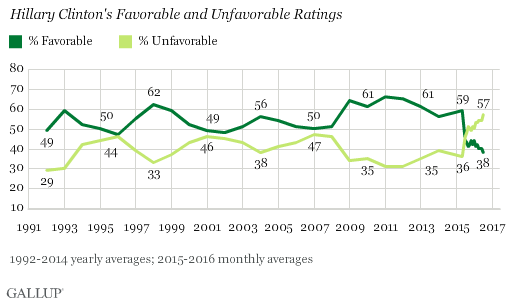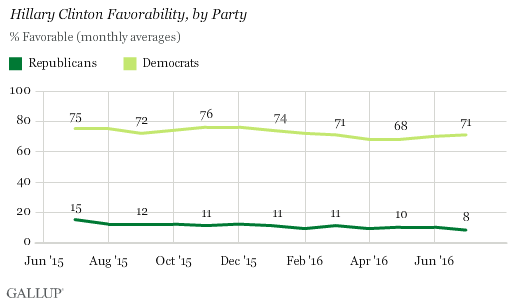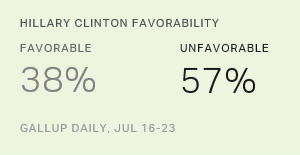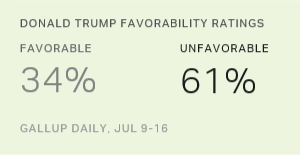Story Highlights
- 38% view Hillary Clinton favorably, 57% unfavorably
- Her favorable percentage was 55% as recently as two years ago
PRINCETON, N.J. -- As the Democratic National Convention gets underway in Philadelphia, Hillary Clinton's image is at its lowest point in the 24 years of her national career, with 38% of Americans viewing her favorably and 57% unfavorably. Americans' most positive view of Clinton, 67% favorable, came in December 1998. Before last year, her lowest favorable ratings since she became well-known had been 43% in January 1996 and 44% in March 2001.

Clinton was at 41% favorable in mid-June but drifted down to 37% by mid-July. Her favorable ratings have since held near that level, including through last week's Republican National Convention. Republican nominee Donald Trump's image for the past seven days was 36% favorable and 59% unfavorable, only slightly less positive than Clinton's.
Gallup first measured Hillary Clinton's image in 1992 as her husband campaigned for the Democratic presidential nomination. Her image, like Bill Clinton's, was mixed in the spring of that year but then grew more positive. Her favorable ratings were above 60% at several points in 1993, and more than six in 10 Americans viewed her favorably at other points as well: when her husband was impeached by the House and tried by the Senate in 1998 and 1999, from 2009 through 2013 while she served as secretary of state, and in April 2013 after she returned to being a private citizen.
After launching her campaign last year and as her handling of emails while secretary of state became an increasingly public and controversial issue, Americans' views of Clinton began their downslide.
Americans' history of changing their views of Clinton from positive to negative and back to positive since 1992 suggests it's possible -- although not highly likely, given recent trends -- that her image could improve as the Democratic convention unfolds this week. Overall, 55% of Americans viewed her favorably and 39% unfavorably from 1992 through 2014. That long-term average is almost an exact flip of her current 38% favorable, 57% unfavorable rating. This shows how much more negatively the public views her now in the midst of her campaign and email controversy than they have historically.
Both Clinton's and Trump's unfavorable ratings are among the highest of any contemporary presidential candidates. The only comparable situation was in the 1992 presidential race. That year, Americans at times held similarly negative views of independent candidate Ross Perot (after he dropped out and then re-entered the campaign) and incumbent Republican President George H.W. Bush as he sought re-election.
Democrats' Favorable View of Clinton at 71%
Seventy-one percent of Democrats and Democratic-leaning independents view Clinton favorably, compared with fewer than one in 10 Republicans. Democrats were slightly more positive about Clinton last summer and through the winter, and were slightly less positive in April and May as she battled Bernie Sanders for the Democratic nomination. Republicans' favorable views have drifted down somewhat over the past 12 months from their already low starting point.

Over the past seven days, spanning the Republican convention at which he accepted his party's nomination, Trump's favorable rating among Republicans improved slightly, to 72%. He and Clinton now have nearly identical favorable ratings among their respective partisans.
Implications
Two highly unpopular candidates are waging the 2016 presidential campaign. Clinton enters her convention with almost six in 10 Americans holding a negative opinion of her, similar to Americans' negative views of her opponent, Trump.
Clinton is one of the best-known politicians in the U.S., with almost a quarter-century of national public exposure as a first lady, a U.S. senator, a secretary of state and now a candidate for president. While Americans' positive views of Clinton have moved up and down over the years, she now is on the verge of accepting the Democratic Party's presidential nomination with an image that is as negative as it has ever been.
A positive image is obviously not all it takes to win the presidency; two of the previous three Democratic nominees had majority-favorable images but ultimately lost. Plus, the parallel unpopularity of Clinton's opponent this year makes it a unique situation in which many voters will choose the least objectionable of two candidates they don't admire. Still, Clinton would clearly rather have a positive than negative image going into the last three months of the campaign, and now faces the significant challenge of attempting to rehabilitate her image to at least some degree during the convention week in Philadelphia.
Historical data are available in Gallup Analytics.
Survey Methods
Results for the latest seven-day averages are based on telephone interviews conducted July 16-23, 2016, on the Gallup U.S. Daily survey, with a random sample of 3,545 adults, aged 18 and older, living in all 50 U.S. states and the District of Columbia. For results based on the total sample of national adults, the margin of sampling error is ±3 percentage points at the 95% confidence level. All reported margins of sampling error include computed design effects for weighting.
Each sample of national adults includes a minimum quota of 60% cellphone respondents and 40% landline respondents, with additional minimum quotas by time zone within region. Landline and cellular telephone numbers are selected using random-digit-dial methods.
Learn more about how the Gallup U.S. Daily works.




